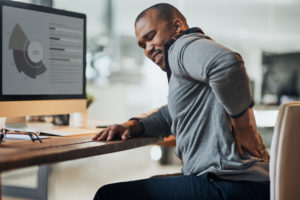 We usually wish to sit down after we have had a long day or to give our tired body some rest. The act of sitting is something that, for many people, isn’t as pleasant as it ought to be. Sometimes, sitting can either cause or worsen back pain. This is not a normal occurrence. It should not happen and may indicate that there is an underlying problem in the spine that needs to be addressed. Here, list some of the reasons why back pain may occur when sitting.
We usually wish to sit down after we have had a long day or to give our tired body some rest. The act of sitting is something that, for many people, isn’t as pleasant as it ought to be. Sometimes, sitting can either cause or worsen back pain. This is not a normal occurrence. It should not happen and may indicate that there is an underlying problem in the spine that needs to be addressed. Here, list some of the reasons why back pain may occur when sitting.
Seated Back Pain, What’s to Blame?
Seated back pain may occur for several different reasons. It is important to consult with a spine specialist to determine why your back hurts when you sit.
- Herniated disc. A herniated disc is one that has shifted out of natural alignment. This shift can cause the disc to compress on nerve roots and other spinal structures, resulting in pain. Sitting can place stress on the misaligned discs, especially if posture is poor.
- Muscle strain. Sitting is very unlikely to cause a muscle strain. However, if a strain has occurred due to injury or poor body mechanics, sitting can make the discomfort of the strain worse.
- Degenerative disc disease. Spinal discs are small cushions that keep the bones of the spine from rubbing up against each other. The stress that the discs carry can eventually cause them to wear down. The loss of height to a disc can lead to nerve compression. We often see this in the low back, where sitting can increase pressure on the nerves and exacerbate pain.
- Sciatic nerve damage. The sciatic nerve begins in the low back and passes under the buttocks and down the back of the legs. Sitting may trigger or worsen sciatic pain if the nerve is being compressed by a disc, vertebra, or bone spurs. Most people recognize the telltale signs of sciatic pain as shooting discomfort, leg weakness, or numbness down the back of the leg.
- Spinal stenosis. Like degenerative disc disease, spinal stenosis is a problem of wear and tear. Over time, the spinal canal can narrow, often in relation to poor posture or obesity. The shrinking of the spinal canal places pressure on the nerves that pass through it, causing pain that can worsen in various situations.
Treating Back Pain
Back pain can only be treated once it has been properly diagnosed. As you can see from the list above, back pain is not a diagnosis on its own; it is a symptom that results from a structural change in the spine. Therefore, treatment must target the underlying cause of pain. Dr. Albert conducts a thorough consultation and medical history to begin understanding back pain. X-rays or other imaging may then be ordered to identify the source of discomfort.
Many of the conditions that cause acute or chronic back pain can be treated conservatively without surgery. Physical therapy and medications may work quite well to reduce pain. If pain persists despite conservative therapies, injections or minimally-invasive spinal surgery may be necessary. The majority of patients who undergo spinal surgery today achieve very good results.
The sooner that back pain is examined, the better conservative care may work. Call 212-606-1004 to schedule a consultation in our NYC spine center.

